Human Activities Have Altered Sediment Transport in the Yihe River, the Longest River Originating from Shandong Province, China
Abstract
:1. Introduction
2. Materials and Methods
2.1. Study Area
2.2. Data Sources
2.3. Methods
2.3.1. Mann–Kendall Trend Analysis
2.3.2. Wavelet Analysis
2.3.3. Pettitt Mutation Point Test
2.3.4. Double Cumulative Curves
3. Results and Analysis
3.1. Temporal Variations in Precipitation and Sediment Load
3.1.1. Characteristics of Intra-Annual Variability in Precipitation and Sediment Load
3.1.2. Characteristics of Inter-Annual Variability in Precipitation and Sediment Load
3.1.3. Cycle Analysis of the Changes in Precipitation and Sediment Load
3.2. Spatial Variations in Sediment Load
3.3. Human Activities Affecting the Variations in Annual Sediment Load
3.3.1. Impact of Hydraulic Engineering Construction on Sediment Load
3.3.2. Impact of Changes in Water Use and Runoff on Sediment Load
3.3.3. Impact of Land-Use Change on Sediment Load
3.3.4. Impact of Changes in Soil and Water Conservation Measures on Sediment Load
3.4. Temporal Coupling of Influencing Factors with Changes in Basin Sediment Load
3.5. Quantitative Relationship between the Variation in Precipitation, Human Activities, and Sediment Load
3.5.1. Delineation of the Initial Phase and Transitional Phases
3.5.2. Effects of the Variability of Precipitation and Human Activities on Sediment Load
4. Discussion
4.1. Impact of Precipitation and Runoff Changes on Sediment Load
4.2. Impacts of Human Activities on the Sediment Load
4.3. Limitations
5. Conclusions
Author Contributions
Funding
Institutional Review Board Statement
Informed Consent Statement
Data Availability Statement
Acknowledgments
Conflicts of Interest
References
- Abebe, S.; Qin, T.; Zhang, X.; Yan, D. Wavelet transform-based trend analysis of streamflow and precipitation in Upper Blue Nile River basin. J. Hydrol. Reg. Stud. 2022, 44, 101251. [Google Scholar] [CrossRef]
- Walling, D.; Fang, D. Recent trends in the suspended sediment loads of the world’s rivers. Glob. Planet. Chang. 2003, 39, 111–126. [Google Scholar] [CrossRef]
- Wang, J.; Shi, B.; Zhao, E.; Yuan, Q.; Chen, X. The long-term spatial and temporal variations of sediment loads and their causes of the Yellow River Basin. Catena 2022, 209, 105850. [Google Scholar] [CrossRef]
- Chen, Y.; Wang, Y. Variations in basin sediment yield and channel sediment transport in the upper Yangtze River and influencing factors. J. Hydrol. Eng. 2019, 24, 05019016. [Google Scholar] [CrossRef]
- Wu, C.; Ji, C.; Shi, B.; Wang, W.; Gao, J.; Yang, Y.; Mu, J. The impact of climate change and human activities on streamflow and sediment load in the Pearl River basin. Int. J. Sediment Res. 2019, 34, 307–321. [Google Scholar] [CrossRef]
- Ye, Z.; Chen, Y.; Zhang, Q.; Liu, Y.; Zhang, X. Research on sediment discharge variations and driving factors in the Tarim River Basin. Remote. Sens. 2022, 14, 5848. [Google Scholar] [CrossRef]
- Su, X.; Li, X.; Niu, Z.; Wang, N.; Liang, X. A new complexity-based three-stage method to comprehensively quantify positive/negative contribution rates of climate change and human activities to changes in runoff in the upper Yellow River. J. Clean. Prod. 2021, 287, 125017. [Google Scholar] [CrossRef]
- Güçlü, Y. Improved visualization for trend analysis by comparing with classical Mann-Kendall test and ITA. J. Hydrol. 2020, 584, 124674. [Google Scholar] [CrossRef]
- Liu, X.; Xu, Z. Spatial and temporal pattern of extreme temperature during 1961–2018 in China. J. Water Clim. Chang. 2020, 11, 1633–1644. [Google Scholar] [CrossRef]
- Wang, T.; Song, C.; Chen, X. Clarifying the relationship between annual maximum daily precipitation and climate variables by wavelet analysis. Atmos. Res. 2023, 295, 106981. [Google Scholar] [CrossRef]
- Luiza, C.; Débora, M.; Fábio, M. Bootstrap Pettitt test for detecting change points in hydroclimatological data: Case study of Itaipu Hydroelectric Plant, Brazil. Hydrolog. Sci. J. 2019, 64, 1312–1326. [Google Scholar]
- Gao, P.; Deng, J.; Chai, X.; Mu, X. Dynamic sediment discharge in the Hekou–Longmen region of Yellow River and soil and water conservation implications. Sci. Total Environ. 2017, 578, 56–66. [Google Scholar] [CrossRef] [PubMed]
- Chen, H.; Chen, L. Response of runoff variation to the changing environments of karst regions in southwest China. Hydrolog. Sci. J. 2022, 67, 2344–2357. [Google Scholar] [CrossRef]
- Zhou, S.; Yu, B.; Huang, Y.; Wang, G. The complementary relationship and generation of the Budyko function. Geophys. Res. Lett. 2015, 42, 1781–1790. [Google Scholar] [CrossRef]
- Luo, Y.; Wang, H.; Meersmans, J.; Green, S.; Quine, T.; Feng, S. Modeling soil erosion between 1985 and 2014 in three watersheds on the carbonate-rock dominated Guizhou Plateau, SW China, using WaTEM/SEDEM. Prog. Phys. Geog. 2020, 45, 53–81. [Google Scholar] [CrossRef]
- Ruiz-Pérez, G.; Medici, C.; Latron, J.; Llorens, P.; Gallart, F.; Francés, F. Investigating the behaviour of a small Mediterranean catchment using three different hydrological models as hypotheses. Hydrol. Process. 2016, 30, 2050–2062. [Google Scholar] [CrossRef]
- Porto, P.; Callegari, G. Using 7Be measurements to explore the performance of the SEDD model to predict sediment yield at event scale. Catena 2021, 196, 104904. [Google Scholar] [CrossRef]
- Gao, H.; Jin, J. Analysis of water yield changes from 1981 to 2018 using an improved Mann-Kendall Test. Remote. Sens. 2022, 14, 2009. [Google Scholar] [CrossRef]
- Karen, R.; Glenn, A.; Robert, W. Change points in annual peak streamflows: Method comparisons and historical change points in the United States. J. Hydrol. 2020, 583, 124307. [Google Scholar]
- Martínez-Fernández, V.; Solana-Gutiérrez, J.; González del Tánago, M.; García de Jalón, D. Automatic procedures for river reach delineation: Univariate and multivariate approaches in a fluvial context. Geomorphology 2016, 253, 38–47. [Google Scholar] [CrossRef]
- Pettitt, A.N. A Non-Parametric Approach to the Change-Point Problem. J. R. Stat. Soc. C-Appl. 1979, 28, 126–135. [Google Scholar] [CrossRef]
- Sun, P.; Wu, Y.; Gao, J.; Yao, Y.; Zhao, F.; Lei, X.; Qiu, L. Shifts of sediment transport regime caused by ecological restoration in the Middle Yellow River Basin. Sci. Total. Environ. 2020, 698, 134261. [Google Scholar] [CrossRef] [PubMed]
- Wang, H.; Sun, F. Variability of annual sediment load and runoff in the Yellow River for the last 100 years (1919–2018). Sci. Total Environ. 2020, 758, 143715. [Google Scholar] [CrossRef]
- Quan, J.; Xu, Y.; Ma, T.; Wilson, J.; Zhao, N.; Ni, Y. Improving surface water quality of the Yellow River Basin due to anthropogenic changes. Sci. Total Environ. 2022, 836, 155607. [Google Scholar] [CrossRef]
- Yu, Y.; Li, Z.; Lin, J.; Liu, J.; Wang, S. TUPU characteristics of spatiotemporal variation for land use in the Yihe River Basin. J. Nat. Resour. 2019, 34, 975–988. [Google Scholar] [CrossRef]
- He, Y.; Song, J.; Hu, Y.; Tu, X.; Zhao, Y. Impacts of different weather conditions and landuse change on runoff variations in the Beiluo River Watershed, China. Sustain. Cities Soc. 2019, 50, 101674. [Google Scholar] [CrossRef]
- Jia, S.; Zheng, C.; Zhuang, H.; Sang, G.; Wu, W. Evaluation of sustainable utilization of water resources in the Yihe River based on driving Force-Pressure-State-Impact-Response Model. Hydrology 2022, 42, 61–66. [Google Scholar]
- Liu, D.; Ma, C.; Xiang, Y.; Jiang, Z. Hazards of soil erosion and its prevention and control in the hilly area of southcentral Shandong Province. Bull. Soil Water Conser. 1983, 1, 38–45. [Google Scholar]
- Li, Z.; Xu, Y.; Wang, H.; Ma, L.; Jiang, A.X. Modeling soil erosion and sediment yield using WaTEM/SEDEM for Yihe River Basin. Geo. Res. 2021, 40, 2380–2396. [Google Scholar]
- Zhang, Y.; Zhao, Q.; Ai, M.; Sang, G.; Zhao, S. Spatial-temporal scale analysis of rainfall and rainfall erosivity in Yihe River Basin. J. Shandong Univ. Eng. Sci. Ed. 2023, 53, 122–132. [Google Scholar]
- Liu, Y.; Wang, H.; Lin, Y.; Cao, L.; Zhang, S.; Ge, W.; Han, G.; Chen, H.; Shi, S. Assessing the contributions of human activities to runoff and sediment transport change: A method for break point identification in double mass curves based on model fittin. J. Hydrol. Reg. Stud. 2023, 50, 101589. [Google Scholar] [CrossRef]
- Duan, J.; Zhu, H.; Dan, L.; Tang, Q. Recent progress in studies on the influences of human activity on regional climate over China. Adv. Atmos. Sci. 2023, 40, 1362–1378. [Google Scholar] [CrossRef]
- Wei, Y.; Jiao, J.; Zhao, G.; Zhao, H.; He, Z.; Mu, X. Spatial–temporal variation and periodic change in streamflow and suspended sediment discharge along the mainstream of the Yellow River during 1950–2013. Catena 2016, 140, 105–115. [Google Scholar] [CrossRef]
- Jia, Y. Analysis of variation trends and cause of runoff and sediment in Yihe River Basin. Res. Soil Water Conserv. 2017, 24, 142–145. [Google Scholar]
- Zhang, H.; Yu, B.; Ni, J.; Wang, J. Susceptibility and periodicity of water and sediment characteristics of mainstream Huaihe River in recent 66 years. J. Yangtze River Sci. Res. Inst. 2020, 37, 6–11. [Google Scholar]
- Zhong, K.; Zheng, F.; Liu, G.; Zheng, X.; Qin, C.; Xu, X. Effects of variations in precipitation extremes on sediment load in the Second Songhua River Basin, Northeast China. J. Soils Sediments 2023, 23, 1971–1984. [Google Scholar] [CrossRef]
- Sun, S.; Zhu, L.; Hu, K.; Li, Y.; Nie, Y. Quantitatively distinguishing the factors driving sediment flux variations in the Daling River Basin, North China. Catena 2022, 212, 106094. [Google Scholar] [CrossRef]
- An, C.; Fang, H.; Wang, F. Characteristics of runoff and sediment yield on slopes and their responses to rainfalls in the upstream of the Miyun Reservoir: A case study of the Shixia Watershed. Sci. Soil Water Conserv. 2020, 18, 43–51. [Google Scholar]
- Chen, X.; An, Y.; Zhang, Z.; Hu, C. Equilibrium relations for water and sediment transport in the Yellow River. Int. J. Sediment Res. 2021, 36, 328–334. [Google Scholar] [CrossRef]
- Sui, J.; He, Y.; Liu, C. Changes in sediment transport in the Kuye River in the Loess Plateau in China. Int. J. Sediment Res. 2009, 24, 201–213. [Google Scholar] [CrossRef]
- Wharton, G.; Mohajeri, S.; Righetti, M. The pernicious problem of streambed colmation: A multi-disciplinary reflection on the mechanisms, causes, impacts, and management challenges. WIREs Water 2017, 4, E1231. [Google Scholar] [CrossRef]
- Wang, Z.; Wu, B.; Wang, G. Fluvial processes and morphological response in the Yellow and Weihe Rivers to closure and operation of Sanmenxia Dam. Geomorphology 2007, 91, 65–79. [Google Scholar] [CrossRef]
- Yan, Y.; Tu, N.; Cen, L.; Gan, F.; Dai, Q.; Mei, L. Characteristics and dynamic mechanism of rill erosion driven by extreme rainfall on karst plateau slopes, SW China. Catena 2024, 238, 107890. [Google Scholar] [CrossRef]
- Zhu, Q.; Yang, X.; Ji, F.; Liu, D.; Yu, Q. Extreme rainfall, rainfall erosivity, and hillslope erosion in Australian Alpine region and their future changes. Int. J. Climatol. 2020, 40, 1213–1227. [Google Scholar] [CrossRef]
- Shi, H.; Hu, C.; Wang, Y.; Tian, Q. Variation trend and cause of runoff and sediment load variations in Huaihe River. J. Hydraul. Eng. 2012, 43, 571–579. [Google Scholar]
- Qiao, X.; Li, Z.; Lin, J.; Wang, H.; Zheng, S.; Yang, S. Assessing current and future soil erosion under changing land use based on InVEST and FLUS models in the Yihe River Basin, North China. Int. Soil Water Conserv. Res. 2024, 12, 298–312. [Google Scholar] [CrossRef]
- Zhang, Y.; Hu, C.; Wang, Y. Analysis on variation characteristics and influential factors of runoff and sediment of Liaohe River Basin. Yangtze River 2014, 45, 32–35+68. [Google Scholar]
- Liu, C.; Wang, Z.; Sui, J. Analysis on variation of seagoing water and sediment load in main rivers of China. J. Hydraul. Eng. 2007, 12, 1444–1452. [Google Scholar]
- Zhang, X.; Chen, C.; Jia, D. Processes of water-sediment and channel pattern of the Songhua River. J. Sediment Res. 2021, 46, 37–43. [Google Scholar]
- Wang, S.; Fu, B.; Piao, S.; Lu, Y.; Ciais, P.; Feng, X.; Wang, Y. Reduced sediment transport in the Yellow River due to anthropogenic changes. Nat. Geosci. 2016, 9, 38–41. [Google Scholar] [CrossRef]
- Shi, H.; Hu, C.; Wang, Y.; Liu, C.; Li, H. Analyses of trends and causes for variations in runoff and sediment load of the Yellow River. Int. J. Sediment Res. 2017, 32, 171–179. [Google Scholar] [CrossRef]
- Wei, D.; Liu, S.; Wu, Y.; Feng, S.; Gao, H.; Qin, C.; Ren, D.; Tang, W.; Zhang, Y. Impacts of human activities and climate change on water and sediment evolution in four large subtropical river basins in China. Ecol. Indic. 2023, 155, 110958. [Google Scholar] [CrossRef]
- Zhao, G.; Mu, X.; Jiao, J.; Gao, P.; Sun, W.; Li, E.; Wei, Y.; Huang, J. Assessing response of sediment load variation to climate change and human activities with six different approaches. Sci. Total Environ. 2018, 639, 73–784. [Google Scholar] [CrossRef] [PubMed]
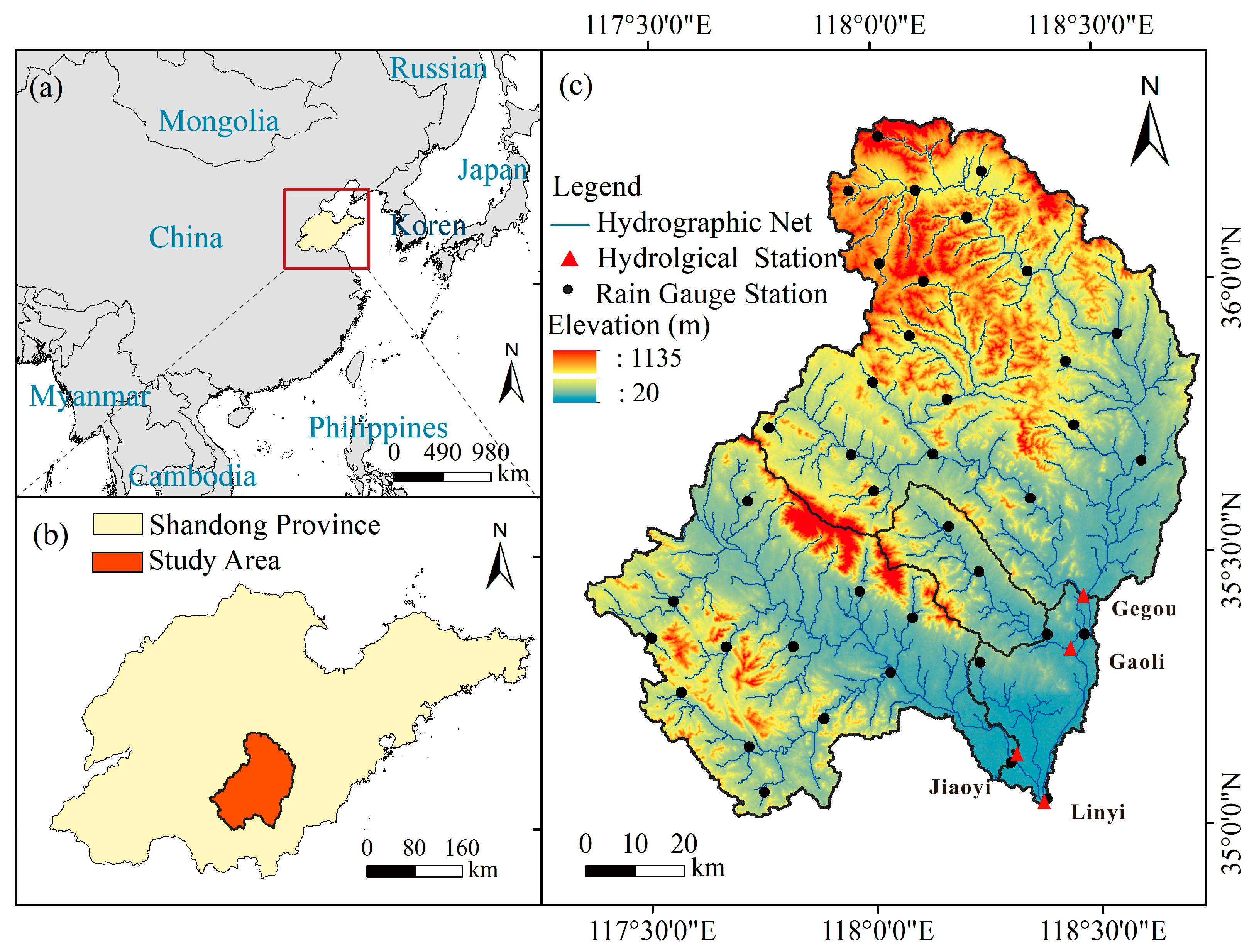
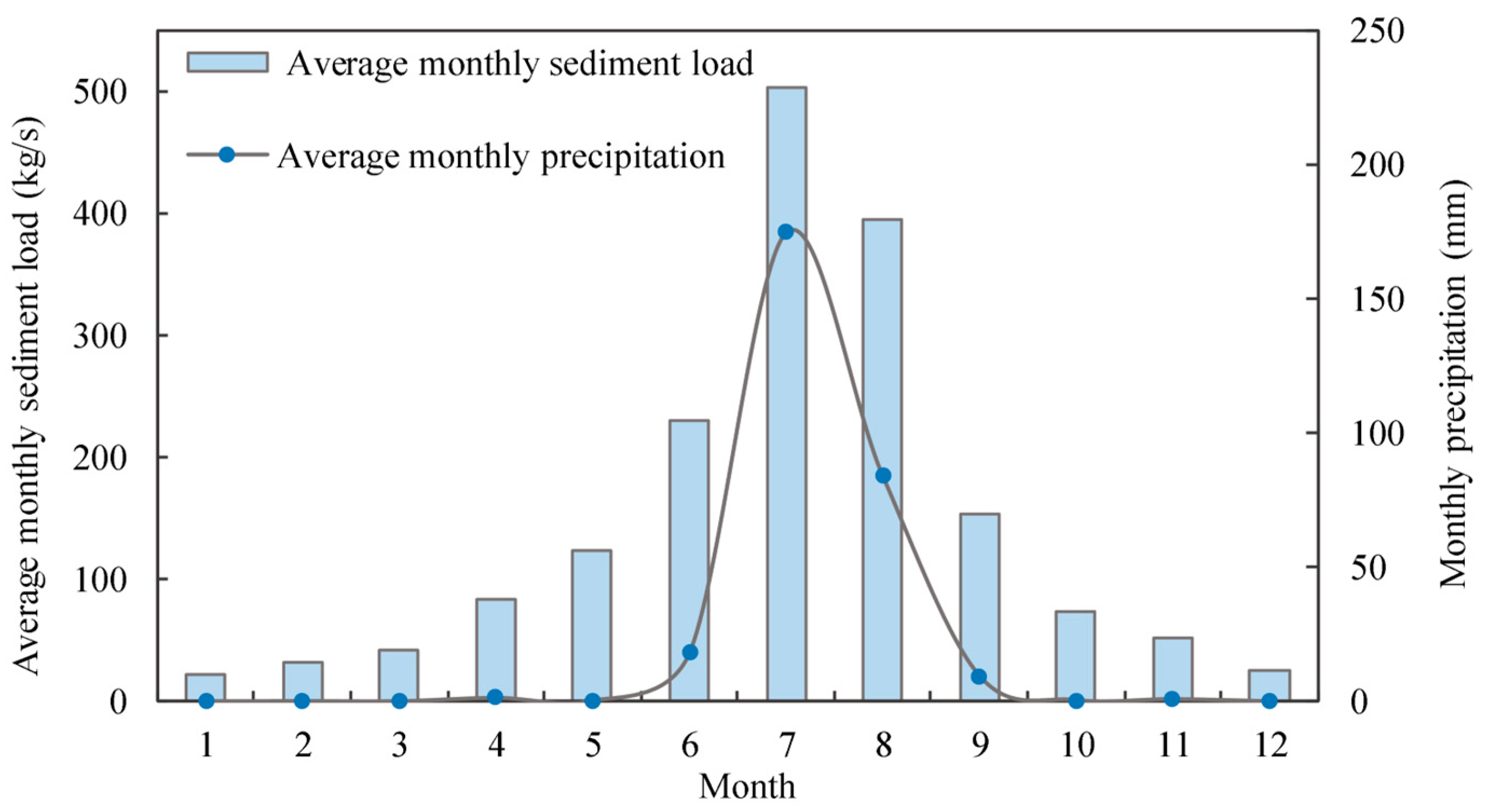
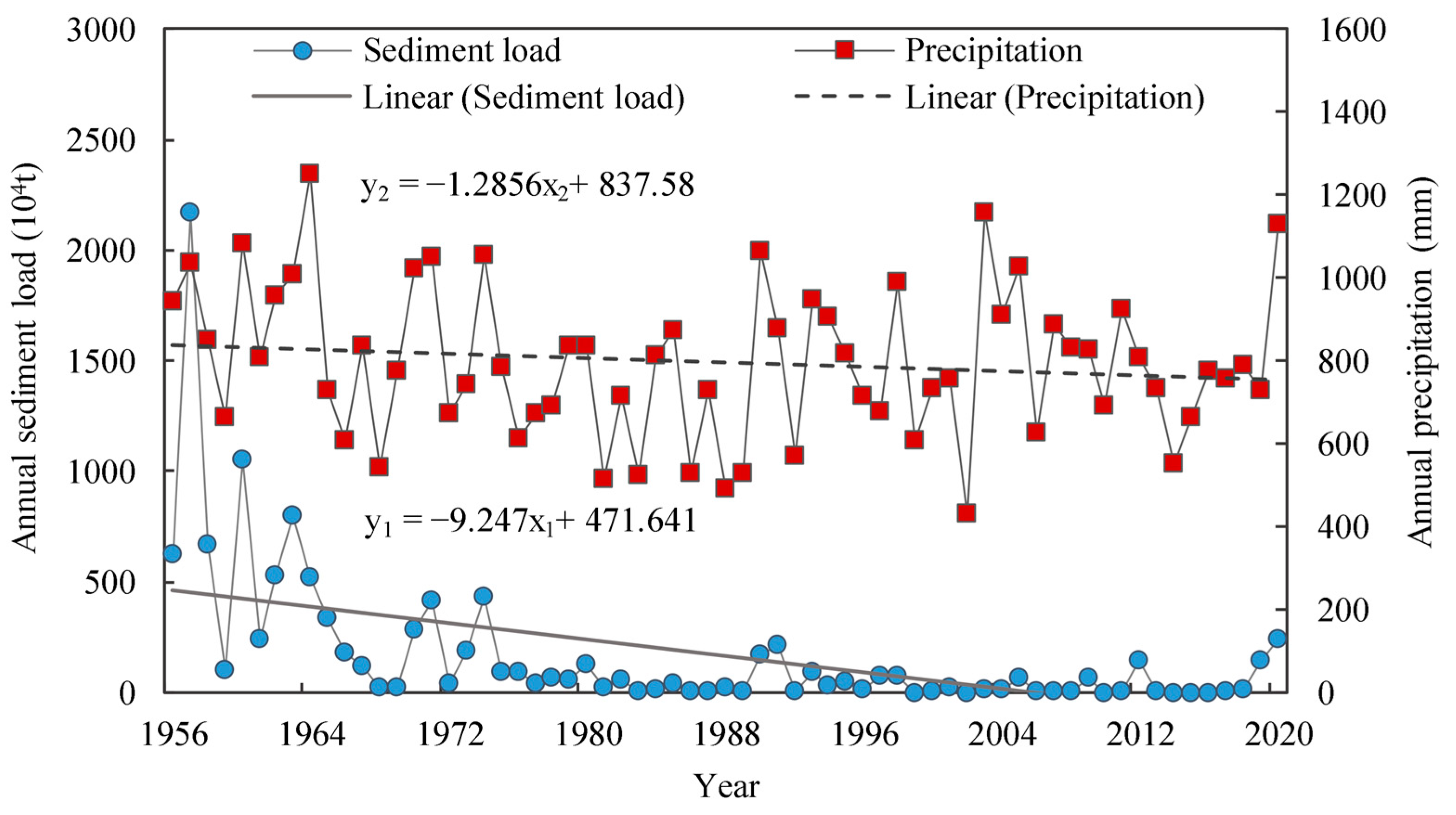


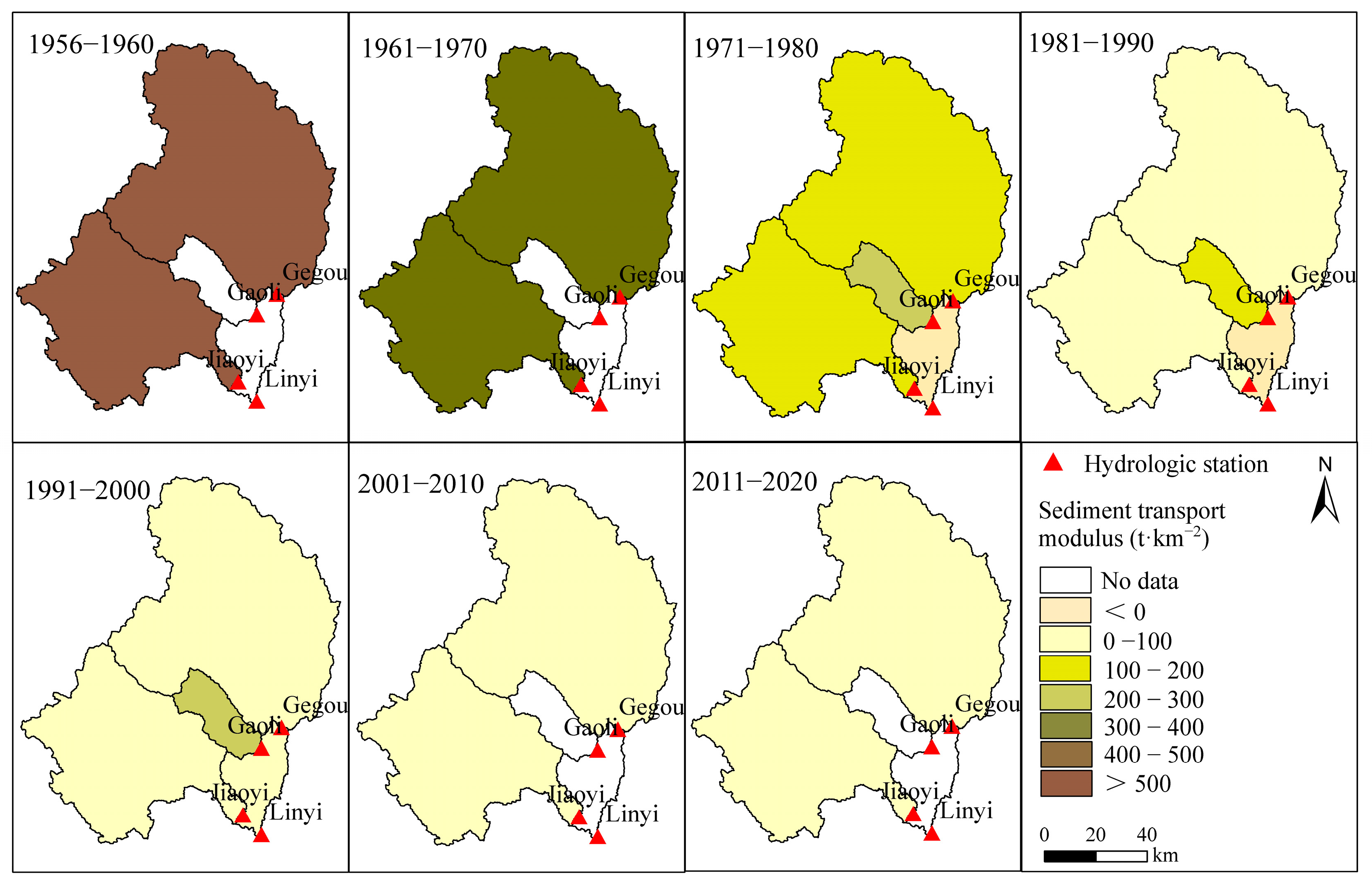
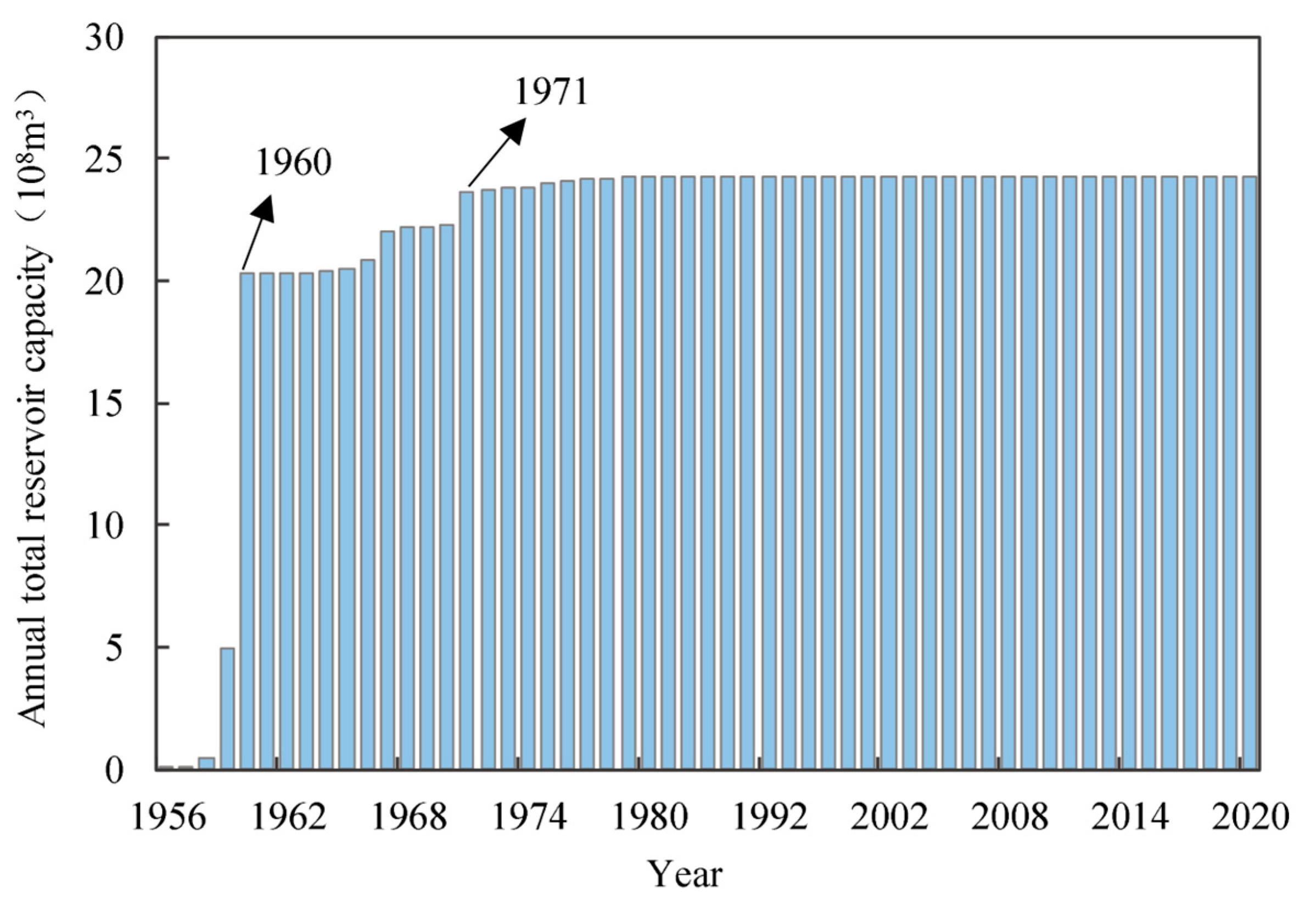
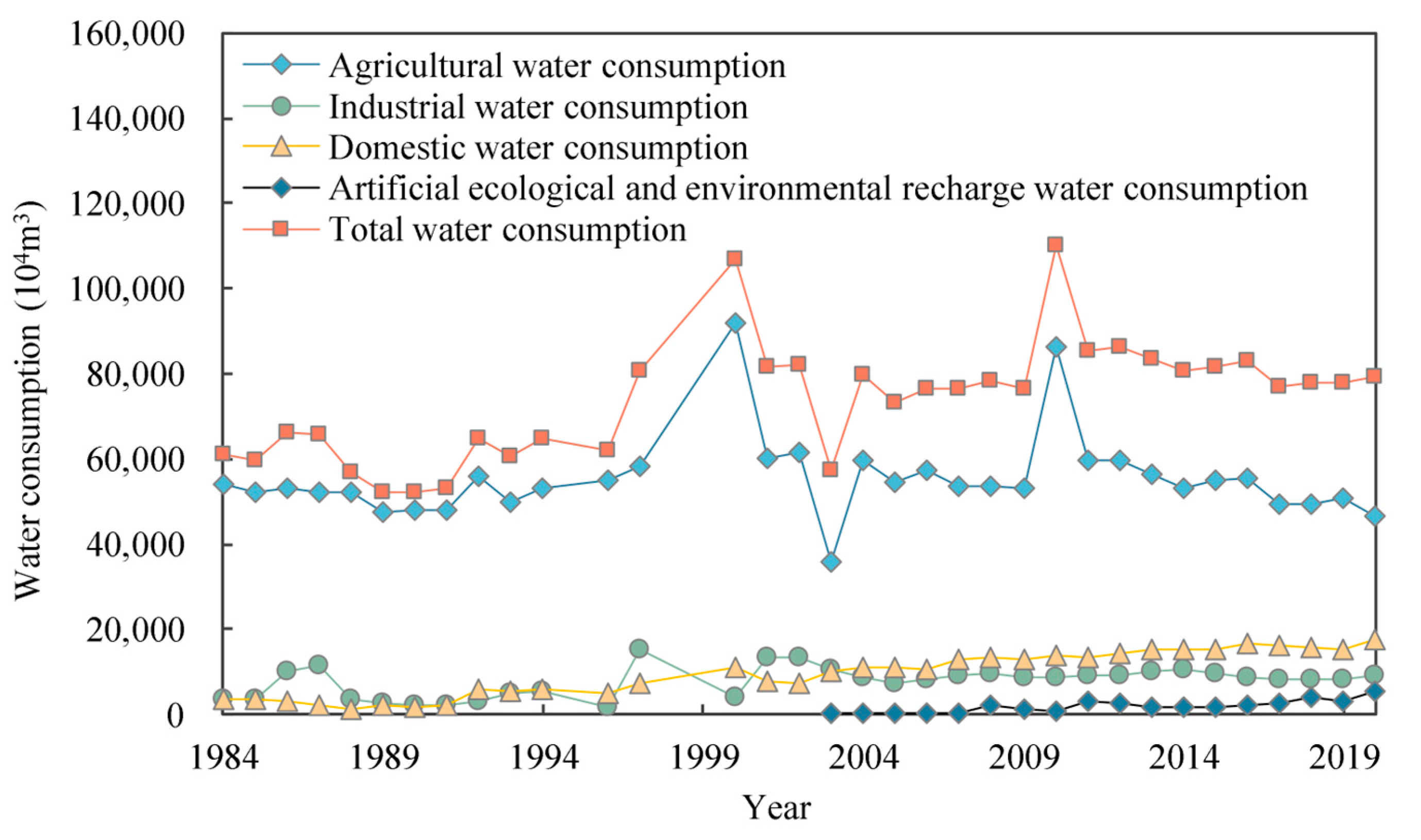
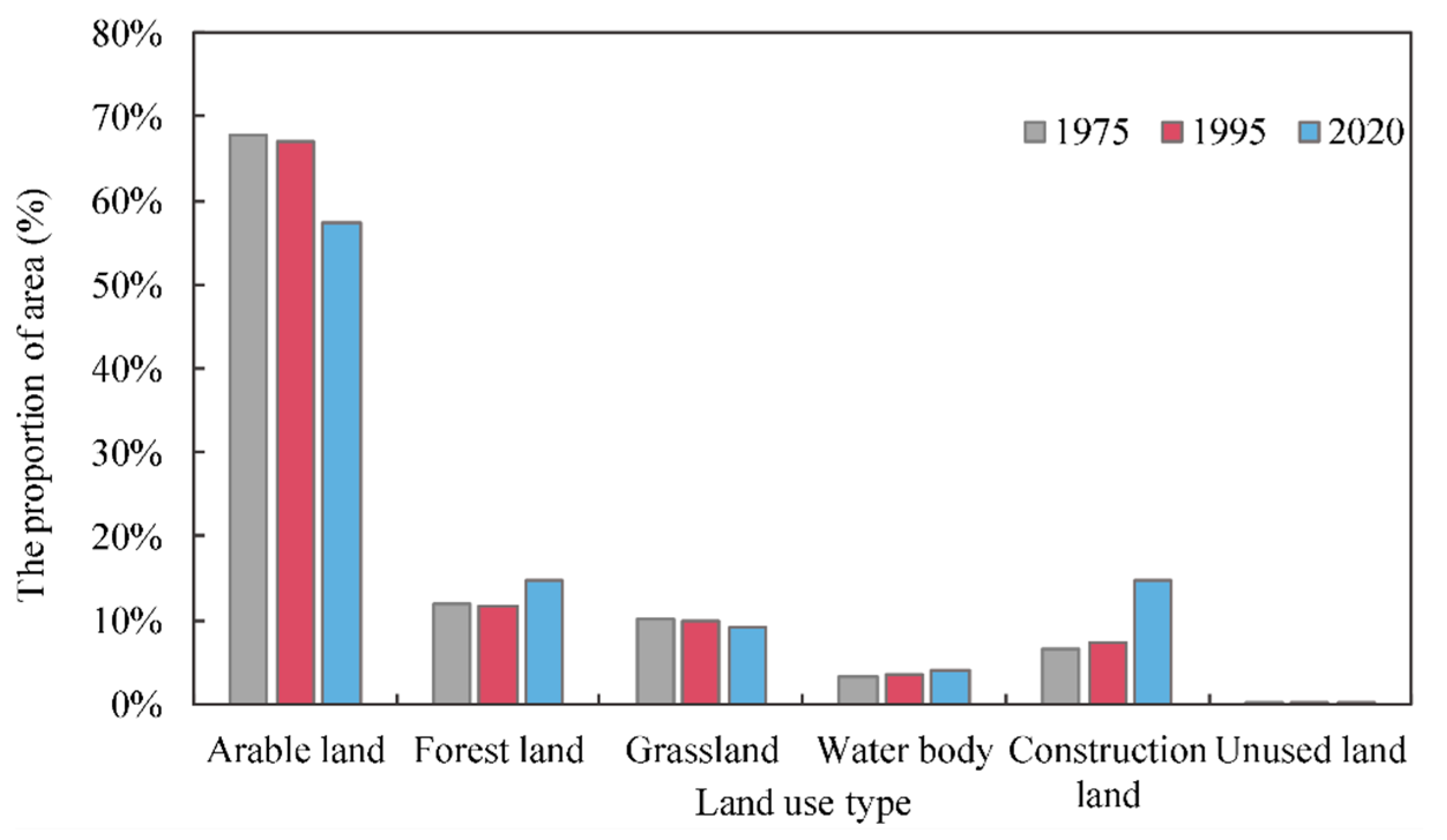

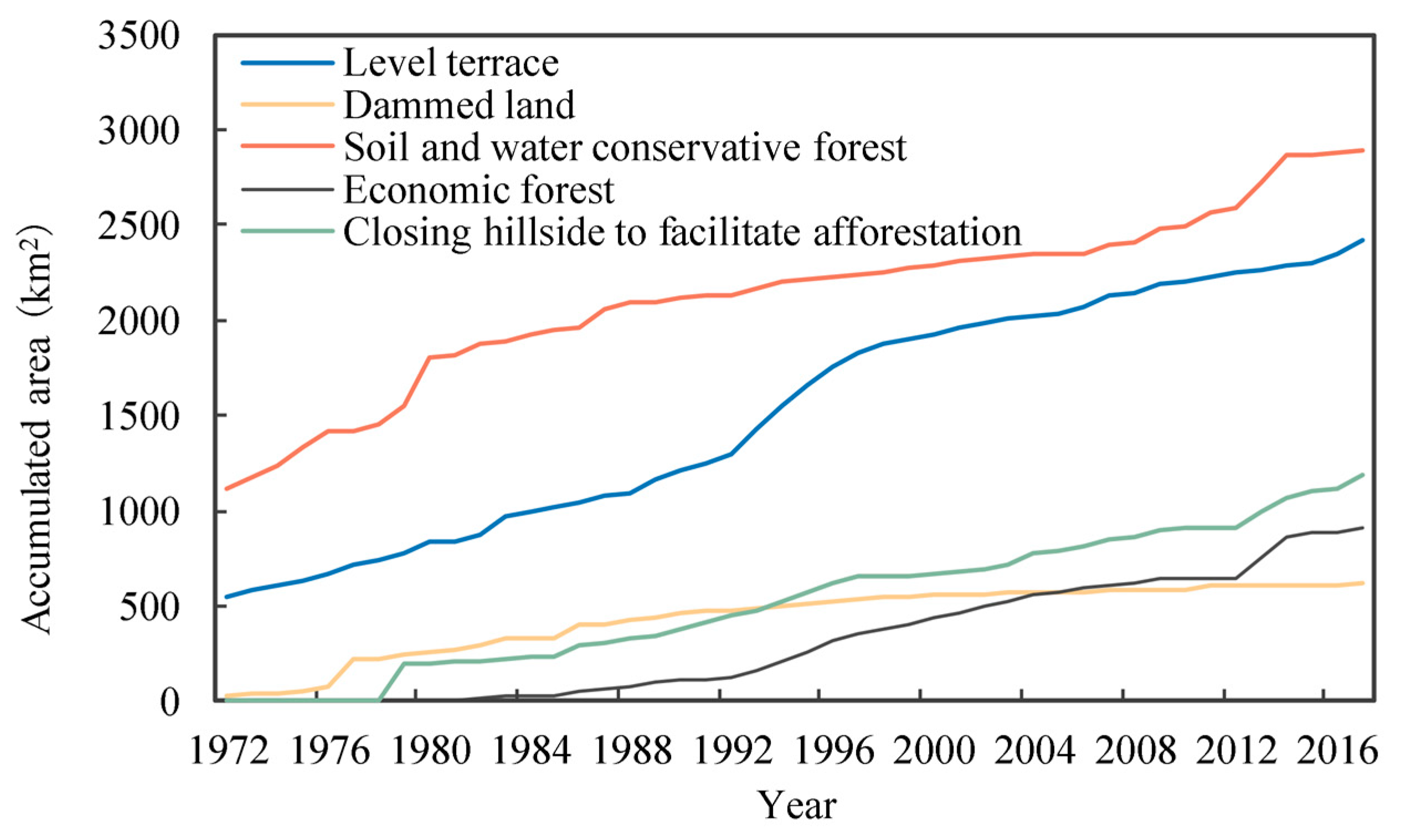
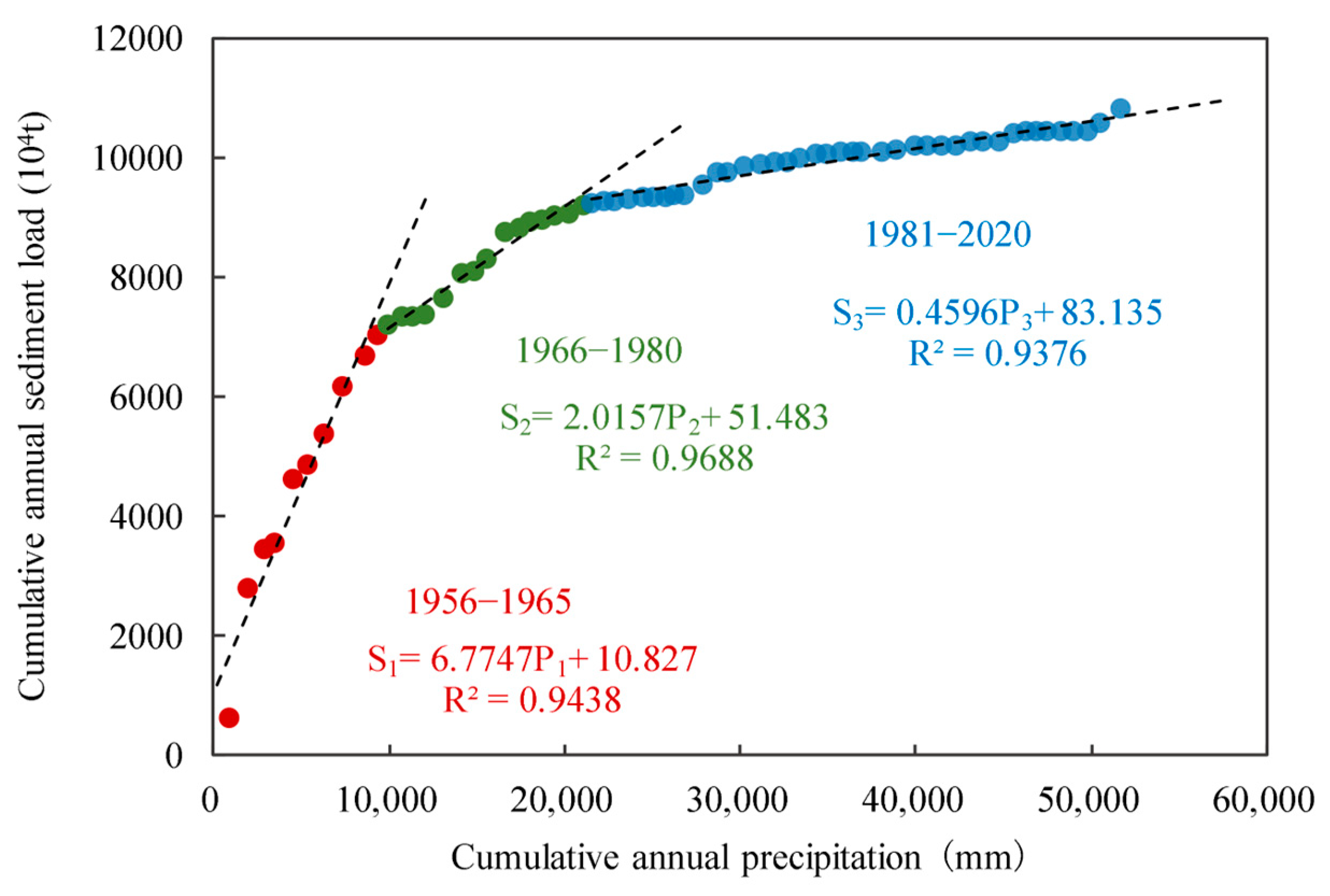

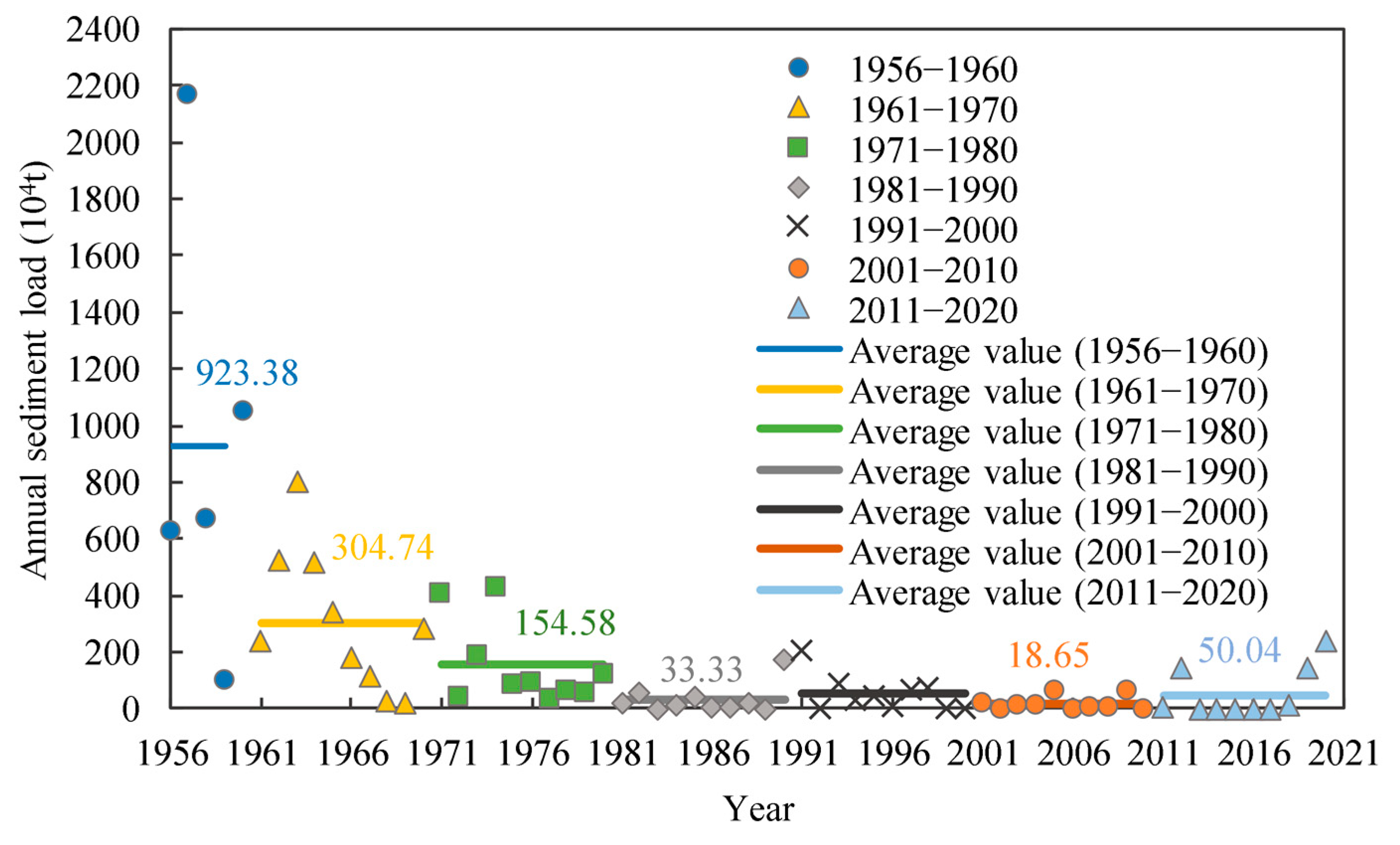
| Period | Precipitation | Sediment Load | ||
|---|---|---|---|---|
| Average Value (mm) | Variation Coefficient | Average Value (104 t) | Variation Coefficient | |
| 1956–1960 | 914.89 | 0.16 | 923.38 | 0.72 |
| 1961–1970 | 853.55 | 0.23 | 304.74 | 0.78 |
| 1971–1980 | 795.01 | 0.18 | 154.58 | 0.90 |
| 1981–1990 | 678.67 | 0.27 | 33.33 | 1.48 |
| 1991–2000 | 784.57 | 0.17 | 54.15 | 1.13 |
| 2001–2010 | 814.33 | 0.24 | 18.65 | 1.28 |
| 2011–2020 | 784.96 | 0.19 | 55.04 | 1.51 |
| 1956–2020 | 795.16 | 0.23 | 166.49 | 5.02 |
| Sub-Basin | Period | Controlled Area (km2) | Average Sediment Load (104 t) | Sediment Transport Modulus (t·km−2) |
|---|---|---|---|---|
| Sub1 | 1957–1967, 1970–2020 | 5509.62 | 50.07 | 90.88 |
| Sub2 | 1976–1997 | 542.92 | 10.34 | 190.45 |
| Sub3 | 1956–1967, 1970–2020 | 3356.58 | 75.23 | 224.13 |
| Sub4 | 1976–1997 | 615.586 | −2.76 | −44.77 |
| Period | Theoretical Sediment Load (104 t/a) | Measured Sediment Load (104 t/a) | Impact of Human Activities | Impact of Precipitation | ||
|---|---|---|---|---|---|---|
| Influence Quantity (104 t/a) | Contribution (%) | Influence Quantity (104 t/a) | Contribution (%) | |||
| 1966–1980 | 553.88 | 144.54 | 409.34 | 73.14 | 150.31 | 26.86 |
| 1981–2020 | 518.69 | 42.41 | 476.28 | 71.97 | 185.50 | 28.03 |
| 1966–2020 | 528.29 | 68.73 | 459.56 | 72.32 | 175.90 | 27.68 |
| Period | Average Precipitation (mm) | K-Value | Division |
|---|---|---|---|
| 1956–1960 | 914.89 | 1.15 | Abundant water |
| 1961–1970 | 853.55 | 1.08 | Flat water |
| 1971–1980 | 795.01 | 1.00 | Flat water |
| 1981–1990 | 678.67 | 0.85 | Dry water |
| 1991–2000 | 784.57 | 0.99 | Flat water |
| 2001–2010 | 814.33 | 1.02 | Flat water |
| 2011–2020 | 784.96 | 0.99 | Flat water |
Disclaimer/Publisher’s Note: The statements, opinions and data contained in all publications are solely those of the individual author(s) and contributor(s) and not of MDPI and/or the editor(s). MDPI and/or the editor(s) disclaim responsibility for any injury to people or property resulting from any ideas, methods, instructions or products referred to in the content. |
© 2024 by the authors. Licensee MDPI, Basel, Switzerland. This article is an open access article distributed under the terms and conditions of the Creative Commons Attribution (CC BY) license (https://creativecommons.org/licenses/by/4.0/).
Share and Cite
Liu, J.; Zheng, S.; Lin, J.; Zhao, M.; Ma, Y.; Chen, B.; Wen, F.; Lu, Z.; Li, Z. Human Activities Have Altered Sediment Transport in the Yihe River, the Longest River Originating from Shandong Province, China. Sustainability 2024, 16, 5396. https://doi.org/10.3390/su16135396
Liu J, Zheng S, Lin J, Zhao M, Ma Y, Chen B, Wen F, Lu Z, Li Z. Human Activities Have Altered Sediment Transport in the Yihe River, the Longest River Originating from Shandong Province, China. Sustainability. 2024; 16(13):5396. https://doi.org/10.3390/su16135396
Chicago/Turabian StyleLiu, Jiayuan, Shuwei Zheng, Jinkuo Lin, Mengjie Zhao, Yanan Ma, Banghui Chen, Fei Wen, Zhijie Lu, and Zijun Li. 2024. "Human Activities Have Altered Sediment Transport in the Yihe River, the Longest River Originating from Shandong Province, China" Sustainability 16, no. 13: 5396. https://doi.org/10.3390/su16135396





